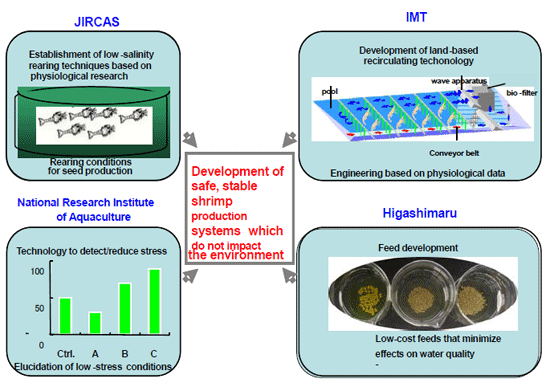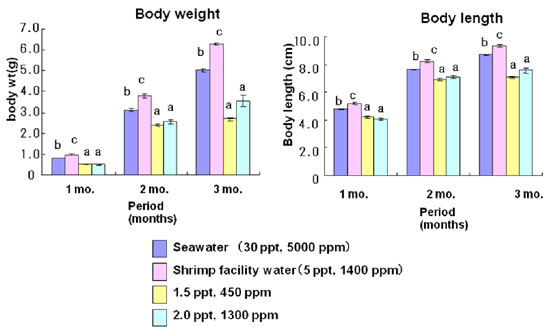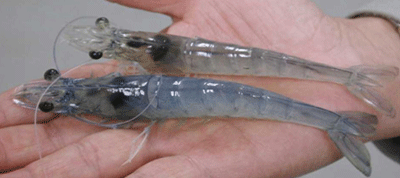Development of land-based recirculating aquaculture systems for domestic production of the whiteleg shrimp Litopenaeus vannamei
Description
At present, marine shrimp farming has become a world-wide industry. According to the FAO’s statistics from 2007, culture activity now amounts to a total annual production of over 3 million tons, which is more than half of the world’s total production of shrimp. Approximately 75% of this production occurs in Asian countries. However, with this dynamic expansion of the industry, we have witnessed the occurrence of myriad environmental problems such as the destruction of mangrove forests for the purpose of shrimp-pond construction, and the deterioration of the coastal environment due to the efflux of waste products from coastally-located shrimp farms. In this regard, it has been recognized by workers in the field that it is necessary to promote new culture technologies that minimize the impact of shrimp farming to the environment.
Along these lines, with funding from the Bio-oriented Technology Research Advancement Institution (BRAIN) of Japan, we have been carrying out an integrated research project “Development of land-based recirculating aquaculture systems for domestic production of the whiteleg shrimp Litopenaeus vannamei” since August, 2004. To this end, JIRCAS formed a research consortium with International Mariculture Technology (IMT) Co. Ltd., an aquacultural engineering firm; Higashimaru, K.K., an aquaculture feed company; and the National Research Institute of Aquaculture. The roles of the respective partners and the project output are depicted conceptually in Fig. 1.
One of the main pillars of this project was to obtain basic physiological data pertaining to osmoregulation, oxygen demand, and ammonia excretion levels of L. vannamei under conditions of re-circulating culture, and to optimize shrimp growth based on the control of water temperature, salinity, and flow rates. For example, in a small-scale experiment, we found that shrimp growth in low-salinity/high-hardness water was equivalent to or better than that in full-strength seawater (Fig. 2). We used this result to develop low-salinity rearing methods, and applied this successfully to commercial large-scale production using IMT’s pre-existing shrimp production facility (commercial-size L. vannamei shown in Fig. 3). At present, our first commercial facility (Indoor Shrimp Production System: ISPS) has been established in Myoko City, Niigata Prefecture, and has been in operation since September, 2007. The facility produces 40 tons of shrimp per year, and the product is being marketed under the trade name, “Myoko Snow Shrimp”.
Since this system is based totally on the use of recirculating water, the impact to the environment is virtually nil. Moreover, an ISPS facility can be established inland, without dependence on the use of fresh seawater, and can be operated based on the usage of a manual. It is expected that the implementation of this technology in developing regions where shrimp farming is a major industry should contribute to the sustainability of aquaculture production and amelioration of the environment.
Figure, table
-
Fig. 1.
Conceptual diagram of the L. vannamei research consortium showing roles of respective research partners and project output. -
Fig. 2.
Results of a small-scale experiment to determine optimal salinity and hardness of the rearing water. Using 60-L aquariums, it was found that low-salinity (5 ppt)/high-hardness (1400 ppm) water provided excellent growth rates in terms of body weight and length. -
Fig. 3.
Commercial-sized Litopenaeus vannamei. In the ISPS facility, shrimp can be reared to market size of 16-20 g within 4 months.
- Affiliation
-
Japan International Research Center for Agricultural Sciences Fisheries Division
- Classification
-
Research A
- Term of research
-
FY2008(FY2004~2008・FY2006~2010)
- Responsible researcher
-
Wilder Marcy N. ( Fisheries Division )
ORCID ID0000-0003-2114-2000KAKEN Researcher No.: 70360394Okutsu Tomoyuki ( Fisheries Division )
KAKEN Researcher No.: 40456322KANG Bong Jung ( Fisheries Division )
ORCID ID0009-0004-9970-6923KAKEN Researcher No.: 00649022JASMANI Safia ( Fisheries Division )
JAYASANKAR Vidya ( Fisheries Division )
OKUMURA Takuji ( National Research Institute of Aquaculture )
MIKAMI Kousei ( International Mariculture Technology Compamy Limited )
NOHARA Setsuo ( International Mariculture Technology Compamy Limited )
NOMURA Takeshi ( International Mariculture Technology Compamy Limited )
FUKUSAKI Tatsuo ( Higashimaru Compamy Limited )
KEIDA Koichi ( Higashimaru Compamy Limited )
- ほか
- Publication, etc.
-
Jasmani et al. (2010) Fisheries Science. 76(2): 219-225.
Matsuda et al. NIPPON SUISAN GAKKAISHI, 76:210-212.
Jayasankar et al. (2009) Japan Agricultural Research Quarterly (JARQ), 43: 345-350.
- Japanese PDF
-
2009_seikajouhou_A4_ja_Part2.pdf278.42 KB



